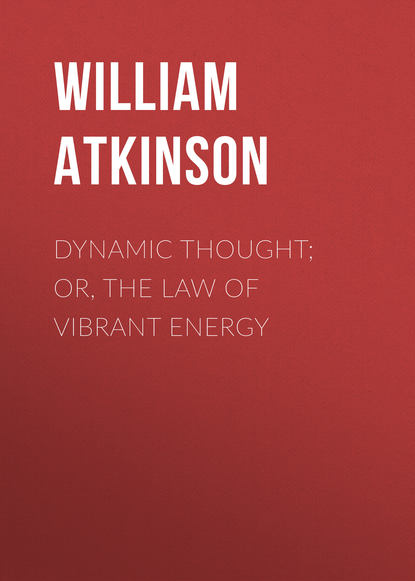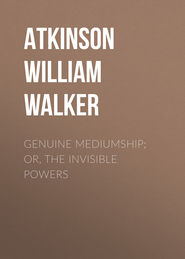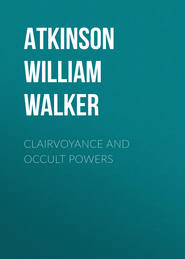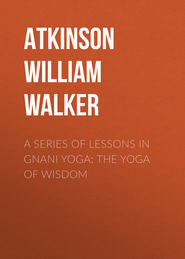По всем вопросам обращайтесь на: info@litportal.ru
(©) 2003-2024.
✖
Dynamic Thought; Or, The Law of Vibrant Energy
Настройки чтения
Размер шрифта
Высота строк
Поля
When you handle a coin, an infinitesimal portion of it is worn off – can you figure the size of the molecules composing that part? When a rose throws off its perfume, it emanates tiny particles of itself – can you measure or weigh the molecules composing that odor? The human mind is compelled to realize its finiteness when it considers these things – but we have only just begun to consider the smallness of Things.
An "Atom" is the chemical unit of Substance – that is, the smallest chemical part that can enter into combination. It has been considered indivisible – that is, incapable of further sub-division. That is, it has been so considered, until very recently, but the latest discoveries have exploded this idea, and have shown the Atom is composed of certain other Things, as we shall see a little later on. Still we may use the Atom as a very good unit of measurement, for it still represents the unit of chemical Substance, just as the molecule is the unit of physical Substance. In order that you may understand the difference between Molecules and Atoms – physical units, and chemical units, let us give you a few examples.
Take a molecule of water – the physical unit, you remember. When it is chemically separated or analyzed, it is found to contain two atoms of hydrogen, and one atom of oxygen – both chemical units, remember – which when united and combined, form water, but which when separated are simple atoms of certain chemical gases. The proportion in water is always the same, two of hydrogen and one of oxygen – this is the only partnership that will form water. The molecule of table salt contains one atom of sodium and one of chlorine. The molecule of air contains five chemical gases, of which nitrogen and oxygen are the principal ones, the proportion being about three parts of nitrogen to one of oxygen. Some molecules are far more complex, for instance the molecule of sugar is composed of forty-five chemical atoms, and sulphuric acid of seven. An atom is estimated at one-250,000,000th of an inch in diameter.
But this is not all. The old theory of the finality, and ultimateness of the Atom has been shattered by the recent discoveries of Science. The atom of Hydrogen was formerly considered to be the refinement of Substance – the Ultimate Atom – the smallest and finest Atom possible or known – the last thing that could be imagined about Substance. Some even went so far as to declare that the Atom of Hydrogen was the Ultimate Element, that is the Element out of which all other atoms were made – the mother of Atoms – the Origin of Substance. It was supposed that all other Atoms of Matter were composed of a varying number of hydrogen Atoms, which themselves were "vortex-rings in the Ether" – and that analysis could go no further. Science rested on its oars, and pronounced the work of a century completed.
But alas! no sooner was this position reached, than the discovery of Radiant Matter and the formulation of the "Corpuscle Theory" brought down the whole theoretical structure, and Science was compelled to take up the hunt again, and to probe further into the inner recesses of Things for the Ultimate Thing. But, nevertheless, Atoms still exist, although their finality is no longer urged. The facts remain, although the theory has fallen.
Let us see about this latest theory – the Corpuscle or Electron Theory. The discovery of Radiant Matter, and the investigation of the late discovery of Radium, has led to the further discovery that each Atom, instead of being a "thing-in-itself" is a little mass containing numerous other "Things" called "Corpuscles" (or "Electrons," because electrified). The theory is this, briefly: That each Atom is a minute mass of Substance containing a number of "electrified particles," which are known as Electrons, in constant motion and vibration, revolving around each other, as do the planets, suns, and moons of the Universe – in fact each chemical Atom is like unto a Universe in itself. The simplest Atom – that which was supposed to be the "Ultimate Atom" – the Atom of Hydrogen – is supposed to contain within its tiny self no less than 1,000 minute Corpuscles, which because electrified are called "Electron," revolving in fixed and regular orbits within the containing globe of the Atom. The more complex forms of Atoms are supposed to contain a far greater number of Electrons, the authorities estimating those in an Atom of Oxygen at 10,000; those in an Atom of Gold, 100,000; and those in an Atom of Radium, 150,000. These figures are of course mere "scientific guesses" but when compared with the similar "guess" regarding the size of the Atom, they give a startling illustration of the size of the newly discovered Corpuscle or Electron.
Another authority, for an illustration, asks us to consider a great globe about 100 feet in diameter – that is, of course, 100 feet through its centre. Let the globe represent the Atom. Then imagine 1,000 minute "specks," each the size of a pin-point, composed of Substance, and each containing, as in a capsule, an atom of electricity. Each "speck" is revolving around each other in a regular orbit, in that great "100 feet through" globe, and keeping well away from one another. That will give you an idea of the relative size of the Electrons and Atoms, and the room that the former have to move about in – good many feet between each, you will notice. Lots of room, and plenty to spare. Try to figure out the size of an Electron.
Many readers of the magazines have been confused as to the relation between the Corpuscles and the Electrons (or Ions, as some have called the latter.) The matter is very simple. They are both the same. The Corpuscle is the tiny particle of Matter, which because it is electrified and has thus become the "unit of electricity," is called an "Electron." From the viewpoint of Substance we call the tiny particle a "Corpuscle" – from the viewpoint of Electricity, we call it an "Electron."
These Electrons are the tiny particles that pour forth from the pole in the Crookes' Tube, and constitute what are known as "X Rays," "Cathode Rays," "Becquerel Rays," etc. They also are the particles that are thrown off and emitted by Radium, and similar substances. They exist in the Atom, as explained, but also are found "free" and independent, and in the last condition or state are thrown off in the aforesaid "Rays," and by Radium, etc. So far the Corpuscles are known only as charged with Electricity, and the Electron only as a tiny charge of Electricity with which the Corpuscle is charged. But Science dreams of Corpuscles of Substance other than Electrons, in which case the old Occult teachings of "light dust" and "heat dust," etc., will be verified.
The Electron contains a powerful charge of Electricity, as much in fact as an Atom, 1,000 to 150,000 times its size will carry. But Science is wondering how these highly charged particles manage to hold together in the Atom, so rigidly coherent as to appear indestructible. We think that we may get a hint at the matter a little later on in this book.
Science, or at least some scientists, are wondering whether the "whirl" or vibration of the Corpuscle might not produce that which we call "Electricity," and whether, when this motion is intensified, waves of Electricity will not be emitted. The writer fully agrees with this idea, and finds that it fits closely his own theories regarding Substance and Motion. But the reader is cautioned against falling into the error of many recent popular writers on the subject, some of whom have used terms calculated to convey the idea that the Corpuscle (Electron) is Electricity itself, rather than tiny particles of Substance called Corpuscles, charged with the unitary charge of Electricity, and therefore called "Electrons." But for that matter, Electricity is only known to us as associated with some form of Substance, and not as "a thing-in-itself." We shall see the reason for this as we proceed with this book. These Corpuscles are destined to play a most important part in the theories of Science from now on. They already have overturned several very carefully and laboriously erected theoretical structures – and many more will follow, among the many important ones evidently doomed to the dust-heap being the "vortex-ring" atomic theory, and other theories built upon the Etheric origin of Matter, and other theories concerning the Ether, even to the extent of breaking down the theory of The Ether itself, which theory had almost come to be considered a Law.
We shall further consider the Corpuscles, and their qualities, characteristics, etc., in the next chapter, for they have an important bearing upon the theories advanced in the course of the study of this book.
CHAPTER VI
SUBSTANCE AND BEYOND
SCIENCE has ascribed to Substance certain characteristic qualities which it calls "Properties." It divides these properties into two classes, viz.: (1) Molecular Properties (sometimes called Physical Properties); and (2) Atomic Properties (sometimes called Chemical Properties).
Molecular Properties are those which may be manifested by Substance without disturbing the Molecules, and consequently without affecting the "kind" of Substance.
Atomic Properties are those which concern the Atoms when free from Molecular combination, and which consequently cannot be manifested without changing the "kind" of Substance.
Science, before long, is likely to add a third class of Properties, namely, "Corpuscular Properties," relating to the Corpuscles or particles of Radiant Matter, but, so far, it has not had the opportunity to sufficiently observe these qualities, except in a general way.
There are certain General Properties that seem possessed by both Mass, Molecules, and Atoms – and probably by Corpuscles.
These General Properties are as follows:
Shape: That property whereby Substance "takes up room." This property manifests in three directions, called Dimensions of Space, namely, Length, Breadth, and Thickness.
Weight: That property whereby Substance responds to Gravity. Weight is simply the measure of the attraction.
Impenetrability: That property whereby two bodies of Substance are prevented from occupying the same space at the same time. A nail driven into a piece of wood, simply pushes aside the molecules, and occupies the Space between them. Substance is never actually "invaded" or its actual territory occupied by other Substance.
Indestructibility: That property whereby Substance is prevented from being destroyed or annihilated. Although the forms of Substance may be changed, or transformed into other forms, still, Substance in itself is not destroyed, and cannot be under the existing Laws of the Universe.
Mobility: That property whereby Substance responds to imparted Motion. We shall notice this property in our consideration of Motion. In addition to the Motion of the Mass, and the movements of Molecules and Atoms in response to its Attraction, there is another form of Motion constantly going on, without reference to the Attraction or impressed Motion of the Mass. The Molecules of all bodies are always in a state of rapid Motion, called Vibration. In solids this vibration is short, being restrained by the close cohesive position of the Molecules. But in Liquids, the Molecules being further separated, the vibration is far more rapid, and they move around and slide over each other with comparatively little resistance. In gases and vapors the Molecules have a splendid field for Motion, and consequently vibrate in wide fields and orbits, and dash around with the greatest velocity. The Atoms also are believed to vibrate rapidly, in accordance with their own laws of vibration. And the Corpuscles are believed to far excel the last two mentioned particles in intensity, rapidity and complexity of their vibrations, as we shall see a little later on in the book. All Substance is in constant Motion and Vibration. There is no Rest in Substance.
Inertia: That property whereby Substance may not move unless in response to imparted Motion; nor terminate its Motion, when it is once imparted, except in response to some other manifestation of impressed Force. Science holds that this "impressed Force" or "imparted Motion" must come from without, but the writer holds that Force may also be "expressed" from "within," as may be seen by reference to subsequent chapters of this book.
Attraction: That property whereby particles or bodies of Substance (1) draw other particles or bodies toward themselves; or (2) move toward other particles or bodies; or (3) are mutually drawn together. This property manifests in four forms, generally referred to as separate and distinct from each other, but which the writer believes to be but forms of the same Attractive Power, and which he believes to be a Mental Process, at the last analysis (a revolutionary claim, which will be supported by argument in later chapters of the book). These three forms of Attraction are known as (1) Gravitation; (2) Cohesion; (3) Adhesion; and (4) Chemical Affinity, or Chemism. We are invited to consider them briefly, at this point, further investigation being reserved for our chapters on Motion, and Dynamic Thought.
Gravitation: This term is usually applied to the attraction between Masses of Substance, such as the Sun, the Earth, and Masses of Substance on or about the Earth's surface. However, Newton, who discovered the facts of Gravitation, states the Law, as: "Every particle of matter in the Universe, attracts every other particle," etc.
Cohesion: This term is used to indicate the attraction between Molecules, by which they are combined into Masses or Bodies. Cohesion causes the Molecules to unite and cling together, thus forming the Mass.
Adhesion: This term is used to indicate the attraction between Masses which causes them to "stick together" without a cohesion of their Molecules. Adhesion operates through the adjacent surfaces of the two Masses. It may be considered as a "lesser" form of cohesion.
Chemical Affinity (sometimes called Chemism or Atomic Attraction): This term is used to indicate the attraction between the atoms, by which they combine, unite and cling together, forming the Molecule.
Science has before it the task of naming, and classifying, the attraction between the Corpuscles, by which they combine and form the Atom. But whatever the name, it will be seen that it represents but another manifestation of "Attraction."
Arising from Molecular Attraction, or Cohesion, are several "Properties" peculiar to Masses having Molecules, and resulting from the tendency of the latter to resist separation. We had better consider them briefly, in order to understand the power of Molecular Attraction, and its incidents.
Porosity: That property indicating the distances observed by the Molecules in their relation to each other, which varies in different "kinds" of Substance. All Substance is more or less Porous, that is, has more or less space existing between the Molecules – the degree depends upon the "closeness." Compressibility and Expansibility, sometimes mentioned as "properties," are but results of Porosity.
Elasticity: That property whereby bodies resume their original size and form, after having been compressed, expanded or "bent." The result is caused by the inclination of the molecules to resume their original positions. What is sometimes called "Plasticity" is merely the reverse of Elasticity, and denotes a limited degree of the latter.
Hardness: That condition resulting from Molecular Attraction resisting the forcible entrance and passage of other Substance between the molecules.
Tenacity: That condition resulting from Molecular Attraction resisting the forcible pulling asunder, or tearing apart of the Mass. This condition sometimes is called "Toughness."
Malleability: That condition resulting from Molecular Attraction resisting the forcible separation of the Mass by pounding, hammering or pressure. The resistance is "passive," and consists of the Molecules allowing themselves to assume a spread-out formation, rather than to be forced apart.
Ductility: That condition resulting from Molecular Attraction resisting the forcible separation of the Mass by a "drawing out" process. The resistance is "passive," and consists of the Molecules allowing themselves to be drawn out into a formation of the shape of wire or thread, rather than to be pulled apart.
In any of the above cases, we may intelligently, and with propriety, substitute the words, "Molecules, by means of cohesion, resisting, etc.," for the terms above used, "Molecular Attraction, resisting, etc."
All Masses of Substance (probably Molecules as well) are capable of Expansion and Contraction, both phenomena, in fact, and in degree, resulting from the relation of the Molecules. Contraction is a "crowding together" of the Molecules; Expansion a "getting apart" of them.
Density: The amount of Substance in relation to a given bulk. Volume– the "size" or "bulk" of a body of Substance. Mass– Besides being used to designate a "body" of Substance, composed of two or more Molecules, the term "Mass" is used to designate the "total quantity of Substance in a Body." An application of the above terms may be seen in the following illustration:
A quart of water occupies a certain space – and has a certain "volume," "mass" and "density." Convert the same "mass" of Water into Steam, and it expands to a "volume" of 1700 times that of Water – but, as no molecules have been added, the "mass" remains the same – but as a quart of Steam weighs 1700 times less than the same "volume" of Water, the "density" of Steam is 1700 times less than that of Water. As the "volume" of a given "mass" increases, the "density" decreases in the same proportion – but the "mass" remains the same. "Mass" therefore has two factors, i. e., "Volume" and "Density." The "Density" of a "Mass" is determined by the weight of a certain "Volume" of it.
The above consideration of the "Properties" of Substance dealt only with the Molecular Properties, or Physical Properties, as they are sometimes called – that is, with properties depending upon the existence of the Molecules. When we consider the Molecules as being composed of Atoms, and when we consider the processes whereby these Molecules are built up of, or broken down through the separation of Atoms, we come to the subject of Atomic Properties, or Chemical Properties, as they are often called.
The Atomic Properties of Substance consist principally in the power and manifestation of Motion, in the direction of combination, separation, and the complex motions resulting from the same. This Motion is manifested by reason of Atomic Attraction, sometimes called "Chemical Affinity," which we shall consider a little later on in the chapter.
Atomic Principles, as above mentioned, are best illustrated by a reference to Chemical changes, and we shall now examine the same. And, the better way to consider Chemical Changes is by comparing them with Physical Changes, or Changes of the Molecules.
Some Physical Changes in Substance are brought about by Heat, which tends to separate the molecules, or rather to allow them to spread out away from each other, so long as the high temperature is maintained, the degree of their nearness being influenced by temperature. Other Physical Changes are produced by outside Forces separating the molecules to such an extent – to such a distance – that their cohesive force is lost, and the Solid matter is said to be "broken," or even reduced to dust. Other physical changes are brought about by Electricity, causing the Molecules to separate and disintegrate.
Chemical Changes, as distinguished from Physical Changes, do not involve or deal with Molecules, the action being solely upon the Atoms of which the Molecules are composed. Physical Changes separate Molecules from each other, while Chemical Changes destroy and break up the Molecule, so that its identity is forever lost, its Atoms thereafter either existing free from combinations, or else recombining with other Atoms, and forming new combinations. Chemical changes are occasioned by either physical or chemical agencies. The physical agencies generally employed are heat, electricity, light, pressure, percussion, etc. The principle of Chemical Changes is that the Atoms are possessed of, and subject to, what is called "Atomic Attraction" or "Chemical Affinity," which may be defined as an attraction or "love" existing in varying degrees between Atoms. This Affinity causes Atoms of one element to seek out and ally themselves to Atoms of another element, the element of "choice" or "preference" being strikingly in evidence.
Atoms of different elements form marriages, and cling together in harmony, until, perchance, by some physical or chemical agency, the Molecule is brought in sufficiently close connection with another Molecule composed of different elemental atoms, when, alas! one of the Atoms of our Molecule finds that it has a greater Affinity for some other elemental Atom in the second Molecule, and lo! it flies away, leaving its first partner, and seeking the new charmer. Divorce and re-marriage is a common thing in the world of Atoms – in fact, Chemistry is based upon these qualities.
Physical and Chemical Changes gradually transform solid rock to "earth" or "soil." Disintegration, by the action of changes in temperature, rains and atmospheric influences, and other Physical Changes, have slowly worn down the rocks into "dirt," gravel, clay, loam, etc. And Decomposition by Chemical Change that set the atoms free from their combinations has aided in the work.











